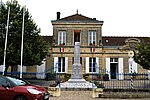The Pair-non-Pair Cave is located near the village of Prignac-et-Marcamps, Aquitaine:Gironde (33) department in France. Only discovered in 1881 it is known for remarkable prehistoric parietal engravings - petroglyphic representations of wild animals (horses, ibexes, cervidae, bovines and mammoths), "which rank among the most ancient examples of art made by prehistoric" humans, dating back to between 30.000 and 25.000 BP, the Aurignacian cultural period of the Upper Paleolithic.The third decorated cave ever to be discovered after Altamira in Spain and the Chabot cave in Ardèche it was the first cave ever to be classified and listed as a historical monument in France on December, 20th 1901. Excavations under the leadership of archaeologist François Daleau (1845 – 1927) began immediately in March 1881 lasting until 1913. Lines on the walls were discovered in 1883 and the first animal engravings came to light in 1896 as the "...authenticity was never questioned, and it became one of the major arguments for the recognition of prehistoric art."










